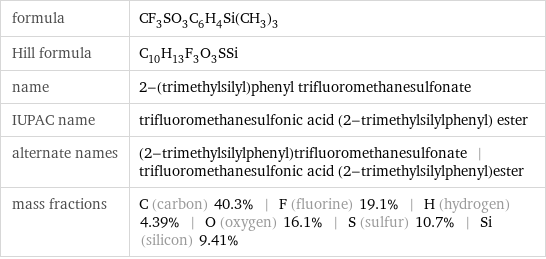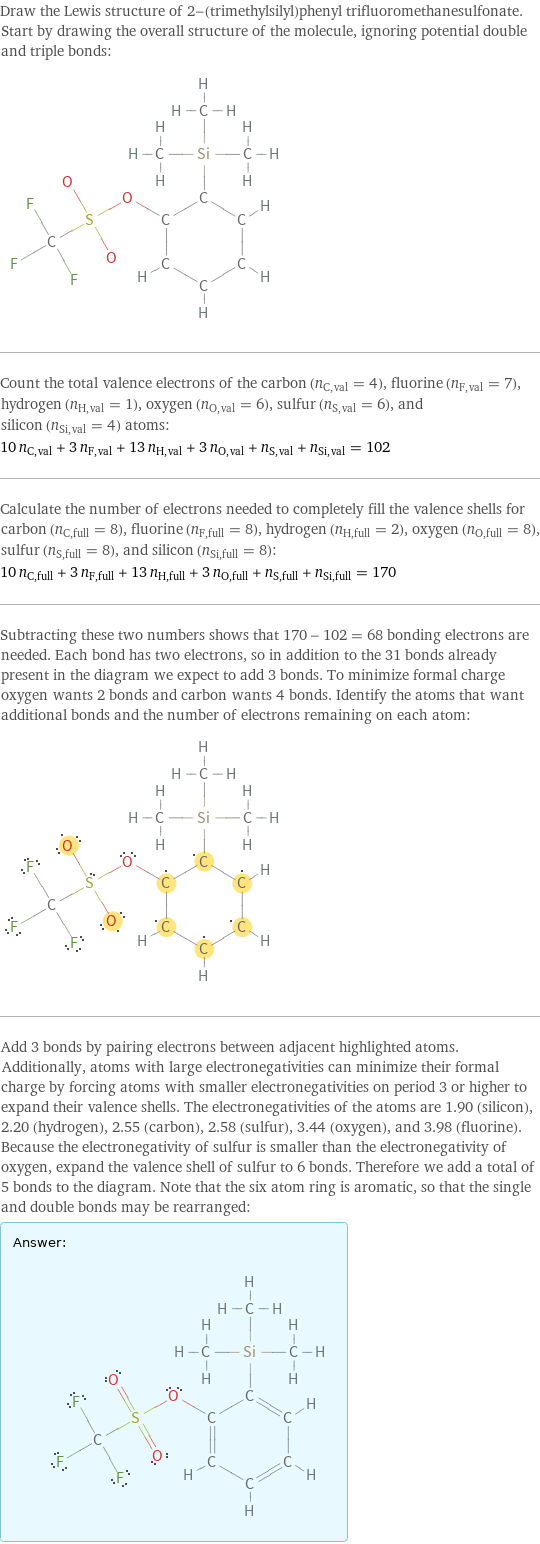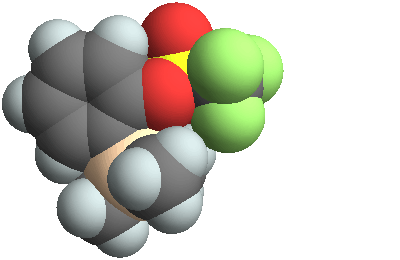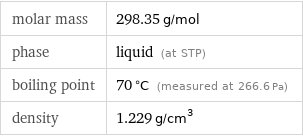Input interpretation

2-(trimethylsilyl)phenyl trifluoromethanesulfonate
Chemical names and formulas

formula | CF_3SO_3C_6H_4Si(CH_3)_3 Hill formula | C_10H_13F_3O_3SSi name | 2-(trimethylsilyl)phenyl trifluoromethanesulfonate IUPAC name | trifluoromethanesulfonic acid (2-trimethylsilylphenyl) ester alternate names | (2-trimethylsilylphenyl)trifluoromethanesulfonate | trifluoromethanesulfonic acid (2-trimethylsilylphenyl)ester mass fractions | C (carbon) 40.3% | F (fluorine) 19.1% | H (hydrogen) 4.39% | O (oxygen) 16.1% | S (sulfur) 10.7% | Si (silicon) 9.41%
Lewis structure

Draw the Lewis structure of 2-(trimethylsilyl)phenyl trifluoromethanesulfonate. Start by drawing the overall structure of the molecule, ignoring potential double and triple bonds: Count the total valence electrons of the carbon (n_C, val = 4), fluorine (n_F, val = 7), hydrogen (n_H, val = 1), oxygen (n_O, val = 6), sulfur (n_S, val = 6), and silicon (n_Si, val = 4) atoms: 10 n_C, val + 3 n_F, val + 13 n_H, val + 3 n_O, val + n_S, val + n_Si, val = 102 Calculate the number of electrons needed to completely fill the valence shells for carbon (n_C, full = 8), fluorine (n_F, full = 8), hydrogen (n_H, full = 2), oxygen (n_O, full = 8), sulfur (n_S, full = 8), and silicon (n_Si, full = 8): 10 n_C, full + 3 n_F, full + 13 n_H, full + 3 n_O, full + n_S, full + n_Si, full = 170 Subtracting these two numbers shows that 170 - 102 = 68 bonding electrons are needed. Each bond has two electrons, so in addition to the 31 bonds already present in the diagram we expect to add 3 bonds. To minimize formal charge oxygen wants 2 bonds and carbon wants 4 bonds. Identify the atoms that want additional bonds and the number of electrons remaining on each atom: Add 3 bonds by pairing electrons between adjacent highlighted atoms. Additionally, atoms with large electronegativities can minimize their formal charge by forcing atoms with smaller electronegativities on period 3 or higher to expand their valence shells. The electronegativities of the atoms are 1.90 (silicon), 2.20 (hydrogen), 2.55 (carbon), 2.58 (sulfur), 3.44 (oxygen), and 3.98 (fluorine). Because the electronegativity of sulfur is smaller than the electronegativity of oxygen, expand the valence shell of sulfur to 6 bonds. Therefore we add a total of 5 bonds to the diagram. Note that the six atom ring is aromatic, so that the single and double bonds may be rearranged: Answer: | |
3D structure

3D structure
Basic properties

molar mass | 298.35 g/mol phase | liquid (at STP) boiling point | 70 °C (measured at 266.6 Pa) density | 1.229 g/cm^3
Units

Liquid properties (at STP)

density | 1.229 g/cm^3 refractive index | 1.456
Units

Chemical identifiers
(C)C1=CC=CC=C1OS(=O)(=O)C(F)(F)F InChI identifier | InChI=1/C10H13F3O3SSi/c1-18(2, 3)9-7-5-4-6-8(9)16-17(14, 15)10(11, 12)13/h4-7H, 1-3H3 MDL number | MFCD00799598](../image_source/a9095a69a67bac471b2185a59be2cce4.png)
CAS number | 88284-48-4 PubChem CID number | 3384007 PubChem SID number | 24870661 SMILES identifier | C[Si](C)(C)C1=CC=CC=C1OS(=O)(=O)C(F)(F)F InChI identifier | InChI=1/C10H13F3O3SSi/c1-18(2, 3)9-7-5-4-6-8(9)16-17(14, 15)10(11, 12)13/h4-7H, 1-3H3 MDL number | MFCD00799598
Safety properties

flash point | 96.11 °C